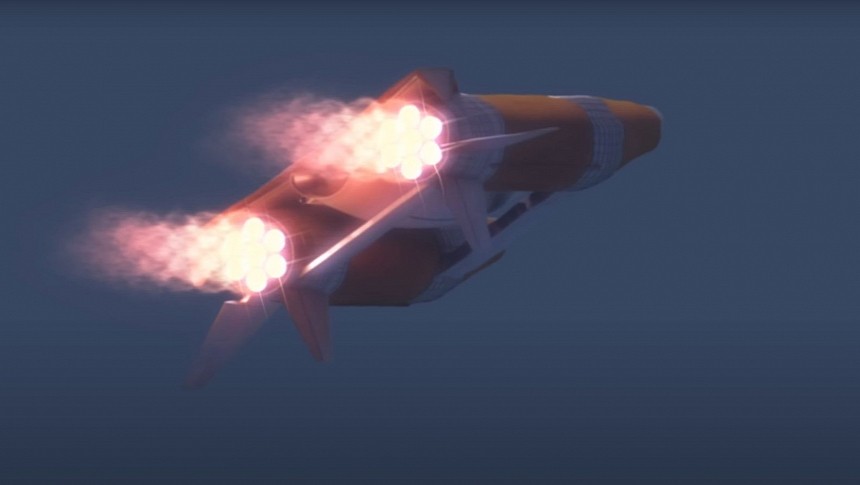It's easy to forget just how many different design proposals were submitted for the Space Shuttle before NASA finally decided on Rockwell's proposal. Something that, at least to their minds, made logical sense. Never mind that the Shuttle was a proverbial brick with wings that had the same flight characteristics as something a stonemason might apply mortar to in a given shift. But after seeing renderings of what Martin Marietta had planned for their space shuttle design, we're almost inclined to say the real thing seems downright practical.
Say hello to the Martin Marietta Spacemaster. This rendering comes to us from the Hazegrayart YouTube page, one of our favorite independent 3D animators out there with a penchant for bringing long-forgotten spacecraft designs that never got off the drawing board to life with impressively detailed animations. Safe to say, the Spacemaster is one of the most wacky designs this channel has ever animated. With dimensions of 420 feet tall (128m) and slated to weigh roughly 1,600,000 kg (3,500,000 lb) between its two stages, the Spacemaster looks more like a water-born catamaran with rocket engines more than it does a traditional spacecraft.
Its crew capsule was intended to rest inside a recess between the two boosters. Said vehicle was due to be based on the Martin Marietta X-24, an experimental lifting-body aircraft that was built in real life and was instrumental in determining the aerodynamic qualities of lifting-body aviation in a practical setting. At launch, presumably from the Kennedy Space Center in Cape Canaveral, Florida, the Spacemaster's 14 core rocket engines would ignite in twin banks of seven while propelling the spacecraft towards the upper atmosphere in preparation for a gravity turn no establish a velocity suitable for low-Earth orbit.
When this was achieved, the spacecraft would separate from its unique booster configuration with whichever payload was designated for the mission in tow. From there, the Spacemaster could've ostensibly stayed in low-Earth orbit for as long as the real-life Space Shuttle did, servicing human-occupied space stations and deploying satellites all the while. When the mission was at its end, the Spacemaster would conduct a de-orbit burn and re-enter the atmosphere at speeds multiple times the speed of sound, just as the Rockwell Space Shuttle orbiters did in our timeline.
Martin Marietta had every intention of building a fleet of Spacemaster orbiters had the program gotten the green light from NASA over other companies who submitted proposals for the Shuttle like Rockwell, Douglas, Lockheed, and Grumman. Thanks to Hazegrayart, we can now visualize what an awesome spectacle such a launch would've been like to see in the flesh. Check out the awesome video in the show notes below. It'll be the most entertaining thing you watch all week.
Its crew capsule was intended to rest inside a recess between the two boosters. Said vehicle was due to be based on the Martin Marietta X-24, an experimental lifting-body aircraft that was built in real life and was instrumental in determining the aerodynamic qualities of lifting-body aviation in a practical setting. At launch, presumably from the Kennedy Space Center in Cape Canaveral, Florida, the Spacemaster's 14 core rocket engines would ignite in twin banks of seven while propelling the spacecraft towards the upper atmosphere in preparation for a gravity turn no establish a velocity suitable for low-Earth orbit.
When this was achieved, the spacecraft would separate from its unique booster configuration with whichever payload was designated for the mission in tow. From there, the Spacemaster could've ostensibly stayed in low-Earth orbit for as long as the real-life Space Shuttle did, servicing human-occupied space stations and deploying satellites all the while. When the mission was at its end, the Spacemaster would conduct a de-orbit burn and re-enter the atmosphere at speeds multiple times the speed of sound, just as the Rockwell Space Shuttle orbiters did in our timeline.
Martin Marietta had every intention of building a fleet of Spacemaster orbiters had the program gotten the green light from NASA over other companies who submitted proposals for the Shuttle like Rockwell, Douglas, Lockheed, and Grumman. Thanks to Hazegrayart, we can now visualize what an awesome spectacle such a launch would've been like to see in the flesh. Check out the awesome video in the show notes below. It'll be the most entertaining thing you watch all week.










